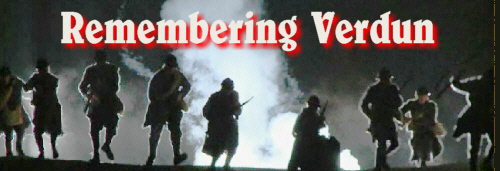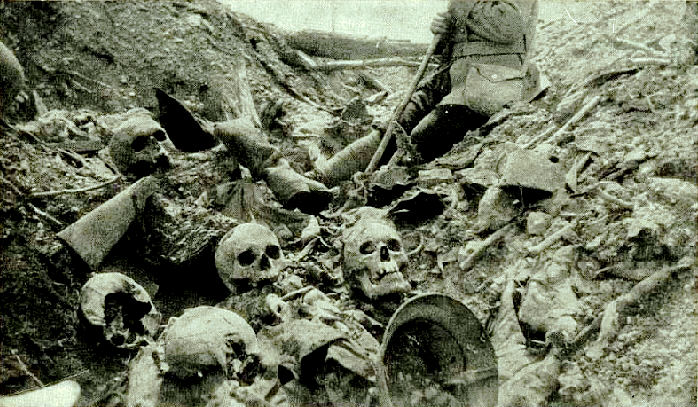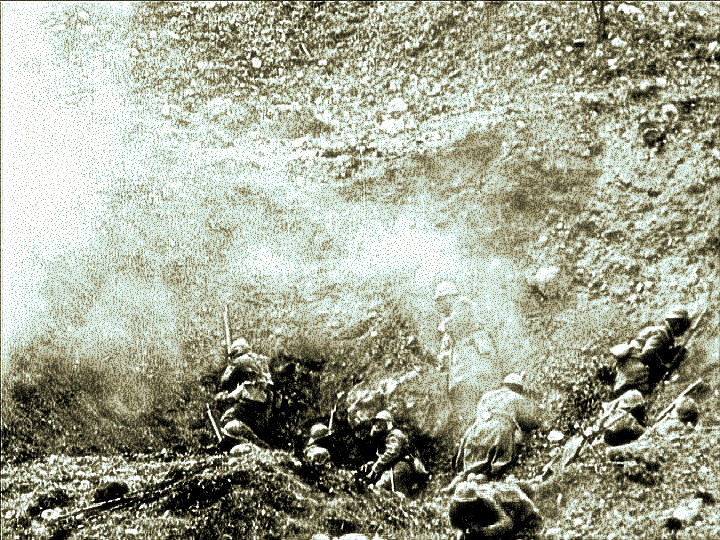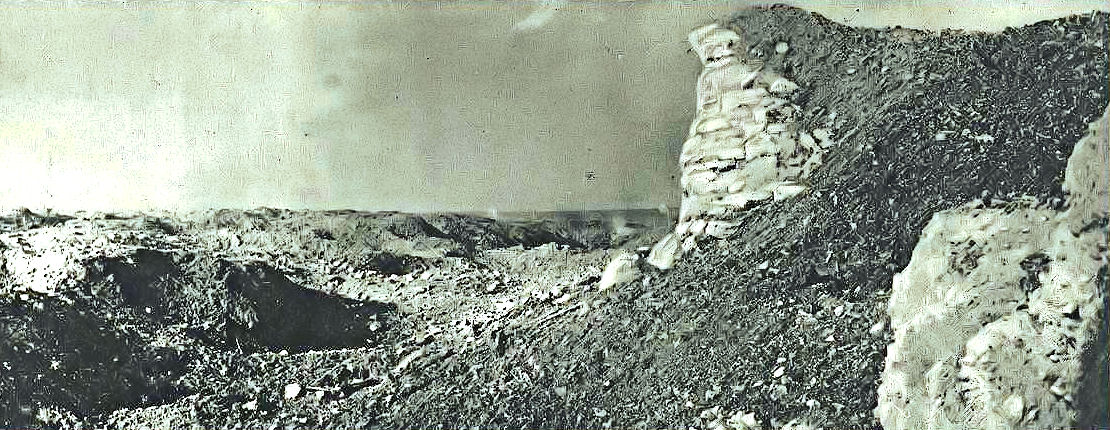
Conceived as a battle of attrition, Verdun is one of history's most memorable testaments to the consequences of that strategy.
Click on Image to Expand
Click on Image to Expand
 |
| The Price of Glory The Verdun Battlefield in 1917 |
Dates: 21 February 1916 – 18 December 1916
Combatants:
German 5th Army [Crown Prince Wilhelm]
French 2nd Army [Herr, Pétain, Nivelle, Mangin]
Stages:
1. February – March: Initial assault on right [east] bank of Meuse includes capture of Fort Douaumont.
2. March – April: German attacks move to left bank, especially against Mort Homme and Hill 304
3. May – September: Relentless attacks and counterattacks; Fort Vaux falls in June; July Somme Offensive by Allies relieves some pressure at Verdun, with German "high-water" point on 11 July and the offense called to a halt on 2 September.
4. October – December: Major French counteroffensive supported by railroad artillery regains most lost territory and Forts Douaumont and Vaux.
Casualty Estimates Vary:
German: 333,000 [incl. 143,000 dead or missing] to 420,000 [175,000]
French: 378,000 [incl: 162,000 dead or missing] to 600,000 [240,000]
Total: 711,000 [incl: 305,000 dead or missing] to 1.1 million [400,000+]
Some Interesting Facts:
 |
| French Troops Under Fire at Verdun |
- Battlefield was about 50 sq miles [30 sq miles on right bank, 20 sq miles on left bank].
- 40,000,000 artillery shells were expended in the battle, about 60% by Germans.
- Under Pétain the French survived the initial crisis, slowing the German advance with a series of counterattacks. He also ensured that the Bar-le-Duc road into Verdun — the only one to survive German shelling — remained open. It became known as La Voie Sacrée ("the Sacred Way").
- French units were rotated frequently; 2/3 of all French divisions served in the sector.
- World War II and Nazi Party notables Charles DeGaulle, Admiral Darlan, Rudolph Hess, Ernst Roehm, Heinz Guderian, and, of course, Marshal Pétain served at Verdun.
- The "Verdun Experience" contributed to the French mutinies of 1917 and led to the "Maginot Line mentality" and the defeat of 1940.
Chronology:
1914 – Early 1915
German efforts to flank the Verdun fortresses in the Argonne Forest (west of the city) and the Woevre Plain and Meuse Heights create a salient around Verdun. Early fighting is concentrated in shoulders of this salient, including intense fighting featuring mining operations around Vauquois in the Argonne and Eparges Spur in the St. Mihiel Salient.
Late 1915
October
Kaiser Wilhelm approves chief of staff's 1916 plan featuring an assault against Verdun.
December
German preparations begin for an assault on the left bank only. Earlier war games had emphasized the need to advance on Verdun along both banks.
1916
21 Feb: Offense begins on right (east) bank of Meuse.
25 Feb: Fort Douaumont captured; Pétain takes over 2nd Army and the defense of Verdun.
6 Mar: German offensive expands to left bank of Meuse. Focus is on two hills controlled by the French, Mort Homme and Cote 304.
9 April: Major attack on left bank.
30 April: Robert Nivelle replaces Pétain as 2nd Army commander.
8 May: Explosion in Fort Douaumont kills 679 German soldiers.
End of May: German forces occupy both Mort Homme and Cote 304.
End of May: German forces occupy both Mort Homme and Cote 304.
7 June: Fort Vaux surrenders
 |
| The View Around Fort Vaux, Late in the Battle |
12 June: Bayonet Trench incident.
23 June: Nivelle's order of the day: "They shall not pass!"
29 June: Hill 304 in German hands.
1 July: Battle of Somme begins relieving pressure on the French.
12 July: Assault on Fort Souville on right bank marks German High-water point at Verdun.
Late August: Falkenhayn resigns as chief of the German General Staff; replaced by Paul von Hindenburg.
4 Sept: Explosion in Tavannes Tunnel kills over 500 French.
24 October: Fort Douaumont abandoned by Germans and recaptured.
2 Nov: Fort Vaux recaptured.
15 Dec: Major French attacks push line back close to February position on right bank.
18 Dec: Major operations around Verdun halted.
1917
20 Aug: Mort Homme recaptured by French.
1918
26 September: American 1st Army launches offensive on left bank, later expanded across Meuse.

To emphasize the nature of the battle. Every year brush areas are bulldozed (with hazard to bulldozer operators) to clear fire lanes in the surrounding shrub forests. While walking there with German friends in the spring of 1966, we easily collected many live cartridges brought to the surface by subsequent rain. I remember opening the cartridges and dumping out the powder to burn to render them less dangerous. Trenches throughout the area still contained potato masher grenades and rusting tin cans which had been opened with bayonets.
ReplyDeleteOne of the things I - and I'm sure a great many others interested in WWI - have learned is to be cautious about accepting contemporary photos at face value. Two of the pics used to illustrate this summary of the Verdun battle ring alarm bells in my mind. One is the collection of skulls and other grisly remains: were they really lying like this, or has the cameraman arranged them to enhance to concentration of effect? Note the skulls all seem to be facing the same way - a piece of unconscious neatness? More improbable is the picture of soldiers taking shelter in the large shell crater: must have been a very brave (and bullet-proof?) cameraman. Or was he working on a movie set? This is not say the photos aren't effective in conveying a probably true impression ... but are they true reportage??? Does anyone have details about these pics that will knock my scepticism on the head?
ReplyDeletefrom what source came the first image?
ReplyDelete